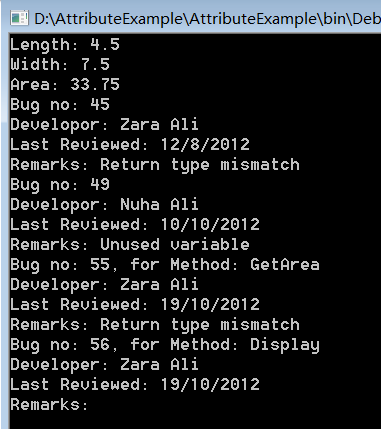C#特性(属性)Attribute
先明确一个概念:
元数据。.NET中元数据是指程序集中的命名空间、类、方法、属性等信息。这些信息是可以通过Reflection读取出来的。
再来看个例子:
#define BUG
//#define NOBUG
using System;
using System.Diagnostics;
namespace AttributeExample
{
public static class AttributeTest
{
[Conditional("BUG")]
public static void OutputDebug(string msg)
{
Console.WriteLine(msg + " : bug");
}
[Conditional("NOBUG")]
public static void OutputMessage(string msg)
{
Console.WriteLine(msg + " : no bug");
}
}
class Program
{
static void Main(string[] args)
{
AttributeTest.OutputDebug("Function");
AttributeTest.OutputMessage("Function");
Console.Read();
}
}
}
运行结果:

将#define BUG注释掉,#define NOBUG的注释取消,重新运行的结果如下:

那么可以理解为,上述代码中的[Conditional()]起到了条件的作用。这就是一种特性。
特性是用于在运行时传递程序中各种元素(类、方法、结构、枚举等)的行为信息的声明性标签。可以通过使用特性向程序中添加声明性信息。这些信息添加到了元数据中。.NET框架中的特性包括Common Attributes和Custom Attributes。其中Common Attributes包括Global Attributes, Obsolete Attributes, Conditional Attributes, Caller Info Attributes。
Common Attributes
- Global Attributes 全局特性,应用于整个程序集。置于using后代码最上端。全局特性提供一个程序集的信息,分为三种类别:
- Assembly identity attributes 程序集标识符特性。name, version, and culture这三个特性用于确定一个程序集的标识符。可以查看一下项目中Properties下面的AssemblyInfo.cs文件。
- Informational attributes 信息特性,提供一些与公司或产品相关的信息,包括AssemblyProductAttribute,AssemblyTrademarkAttribute等。
- Assembly manifest attributes 程序集清单特性。包括title, description, default alias, and configuration。
- Conditional Attributes 标记了一个条件方法,其执行依赖于指定的预处理标识符(#define),实例就是上面那个。条件特性可以同时使用多个。比如[Conditional("A"), Conditional("B")]。
- Obsolete Attributes 标记了不应被使用的程序实体。它可以让您通知编译器丢弃某个特定的目标元素。其语法表示为:[Obsolete(message)]、[Obsolete(message, iserror)]
其中,message是一个string,描述项目为什么过时以及该替代使用什么;iserror是一个bool,如果为true,编译器应该把项目的使用当做一个错误,默认值是false,此时编译器生成一个警告。比如下面的例子:
using System; using System.Diagnostics; namespace AttributeExample { class Program { [Obsolete("Don't use OldMethod, use NewMethod instead", true)] static void OldMethod() { Console.WriteLine("It is the old method"); } static void NewMethod() { Console.WriteLine("It is the new method"); } static void Main(string[] args) { OldMethod(); Console.Read(); } } }
这时程序无法编译,显示如下的错误:

- Caller Info Attributes 通过使用该特性,可以获取调用某个方法的调用者的信息。比如代码的文件路径、代码的行等。比如下面所示的代码。
using System; using System.Runtime.CompilerServices; namespace AttributeExample { class Program { public static void DoSomething() { TraceMessage("Something happened."); } public static void TraceMessage(string message, [CallerMemberName] string memberName = "", [CallerFilePath] string sourceFilePath = "", [CallerLineNumber] int sourceLineNumber = 0) { Console.WriteLine("message: " + message); Console.WriteLine("member name: " + memberName); Console.WriteLine("source file path: " + sourceFilePath); Console.WriteLine("source line number: " + sourceLineNumber); } static void Main(string[] args) { DoSomething(); Console.Read(); } } }
运行结果如图所示:

Custom Attributes
.NET框架允许创建自定义特性,用于存储声明性的信息,且可在运行时被检索。该信息根据设计标准和应用程序需要,可与任务目标元素相关。创建并使用自定义特性包含四个步骤:
1. 声明自定义特性
一个新的自定义特性应派生自System.Attribute类,比如:
// 声明名为FirstAttribute的自定义特性
[AttributeUsage(AttributeTargets.Class, Inherited =false)] class FirstAttribute : Attribute { }
// 声明名为SecondAttribute的自定义特性 [AttributeUsage(AttributeTargets.Class)] class SecondAttribute : Attribute { }
// 声明名为ThirdAttribute的自定义特性 [AttributeUsage(AttributeTargets.Class, AllowMultiple =true)] class ThirdAttribute : Attribute { }
又比如:
// 声明名为CustomAttribute的自定义特性
[AttributeUsage(AttributeTargets.Class| AttributeTargets.Constructor| AttributeTargets.Field| AttributeTargets.Method| AttributeTargets.Property, AllowMultiple =true)] public class CustomAttributes : System.Attribute{}
2.构建自定义特性
上面已经声明了一个名为CustomAttribute的自定义特性,现在构建这个特性。该特性将存储调试程序获得的信息,包括:bug的代码编号、辨认该bug的开发人员名字、最后一次审查该代码的日期以及一个存储了开发人员标记的字符串消息。
CustomAttribute类将带有三个用于存储前三个信息的私有属性和一个用于存储消息的公有属性。因此bug编号、开发人员名字和审查日期将是CustomAttribute类的必需的定位(positional)参数,消息将是一个可选的命名(named)参数。每个特性必须至少有一个构造函数。必需的定位参数应通过构造函数传递,如下面的代码所示:
[AttributeUsage(AttributeTargets.Class| AttributeTargets.Constructor| AttributeTargets.Field| AttributeTargets.Method| AttributeTargets.Property, AllowMultiple =true)] public class CustomAttributes : System.Attribute { public int BugNo { get; } public string Developer { get; } public string LastReview { get; } public string Message { get; set; } public CustomAttributes(int BugNo, string Developer, string LastReview) { this.BugNo = BugNo; this.Developer = Developer; this.LastReview = LastReview; } }
3.在目标程序元素上应用自定义特性
通过把特性放置在紧接着它的目标之前,来应用该特性:
[CustomAttributes(45,"Zara Ali","12/8/2012", Message ="Return type mismatch")] [CustomAttributes(49,"Nuha Ali","10/10/2012",Message ="Unused variable")] class Rectangle { protected double length; protected double width; public Rectangle(double length, double width) { this.length = length; this.width = width; } [CustomAttributes(55,"Zara Ali","19/10/2012", Message ="Return type mismatch")] public double GetArea() { return length * width; } [CustomAttributes(56,"Zara Ali", "19/10/2012")] public void Display() { Console.WriteLine("Length: {0}", length); Console.WriteLine("Width: {0}", width); Console.WriteLine("Area: {0}", GetArea()); } }
4.通过反射访问特性
别忘了使用using System.Reflection;
class ExecuteRectangle { static void Main(string[] args) { Rectangle r = new Rectangle(4.5, 7.5); r.Display(); object[] attrs = r.GetType().GetCustomAttributes(false); // 遍历Rectangle类的特性 foreach(Attribute attr in attrs) { CustomAttributes attribute = (CustomAttributes)attr; if(null != attribute) { Console.WriteLine("Bug no: {0}", attribute.BugNo); Console.WriteLine("Developor: {0}", attribute.Developer); Console.WriteLine("Last Reviewed: {0}", attribute.LastReview); Console.WriteLine("Remarks: {0}", attribute.Message); } } // 遍历方法特性 object[] methods = r.GetType().GetMethods(); foreach(MethodInfo method in methods) { foreach(object attribute in method.GetCustomAttributes(true)) { CustomAttributes attr = attribute as CustomAttributes; if(null != attr) { Console.WriteLine("Bug no: {0}, for Method: {1}", attr.BugNo, method.Name); Console.WriteLine("Developer: {0}", attr.Developer); Console.WriteLine("Last Reviewed: {0}", attr.LastReview); Console.WriteLine("Remarks: {0}", attr.Message); } } } Console.Read(); } }
运行结果如图所示:

参考文献:
1.https://www.runoob.com/csharp/csharp-attribute.html
2.https://www.runoob.com/csharp/csharp-reflection.html
3.https://docs.microsoft.com/en-us/dotnet/csharp/programming-guide/concepts/attributes/
4.https://blog.csdn.net/xiaouncle/article/details/70216951






【推荐】国内首个AI IDE,深度理解中文开发场景,立即下载体验Trae
【推荐】编程新体验,更懂你的AI,立即体验豆包MarsCode编程助手
【推荐】抖音旗下AI助手豆包,你的智能百科全书,全免费不限次数
【推荐】轻量又高性能的 SSH 工具 IShell:AI 加持,快人一步
· 开发者必知的日志记录最佳实践
· SQL Server 2025 AI相关能力初探
· Linux系列:如何用 C#调用 C方法造成内存泄露
· AI与.NET技术实操系列(二):开始使用ML.NET
· 记一次.NET内存居高不下排查解决与启示
· 阿里最新开源QwQ-32B,效果媲美deepseek-r1满血版,部署成本又又又降低了!
· 开源Multi-agent AI智能体框架aevatar.ai,欢迎大家贡献代码
· Manus重磅发布:全球首款通用AI代理技术深度解析与实战指南
· 被坑几百块钱后,我竟然真的恢复了删除的微信聊天记录!
· 没有Manus邀请码?试试免邀请码的MGX或者开源的OpenManus吧